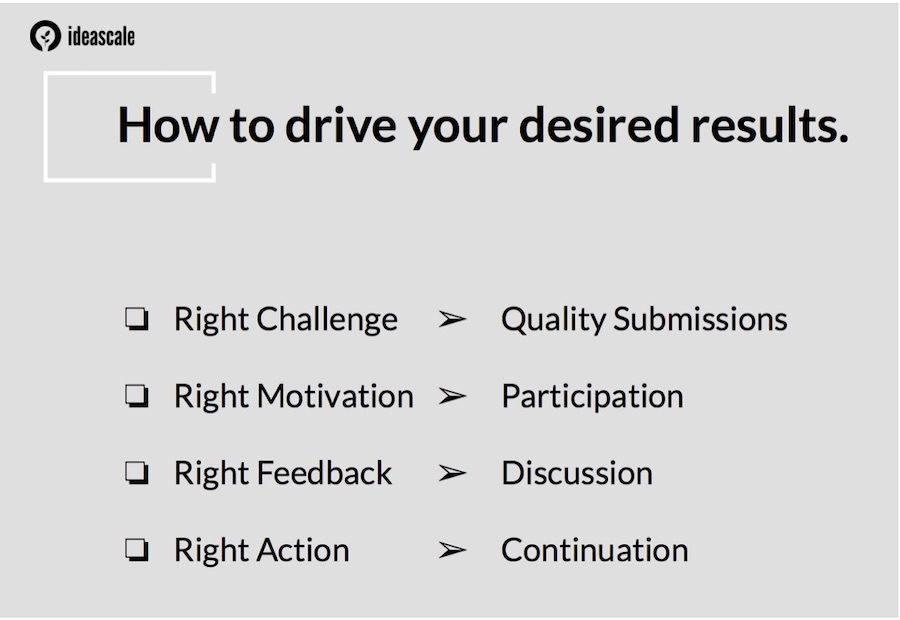In response from clients, I hear different versions of the following statements and questions:
- I’d like to see more quality ideas.
- How can I increase participation on the platform?
- I’d like to see more discussion on the platform.
- How can I drive sustained engagement with the platform?
All of these questions are in fact interrelated and have something to do with meaningful engagement. I am going to attempt to address each of them by answering one central question at the heart of all these questions:
How might we drive sustained meaningful engagement with our innovation program?
In discussing this topic with countless clients over the years, and more recently with clients every day for two months during a recent business tour of Australia, I recently developed a simple figure to explain a comprehensive solution to this very loaded question.

This figure summarizes the following pieces of guidance.
1. Quality submissions require a quality challenge statement.
Conversely, if you have not put much thought into the question you’re asking, how can you expect your
participants to put much thought into the answers they are providing? According to MIT Sloan Management Review, a quality problem statement has 5 elements:
- Organizational relevance
- A clear articulation of the gap between current state and target future state
- Quantifiable success metrics
- Neutrality on diagnosis or solution
- Approachable in scope
For more on how to write a quality challenge statement see here.
2. Align motivators with the participation outcomes you want to see.
Motivating participation is not as simple as offering a cash prize. If you simply offer a prize for the most submissions, you might get poorly developed submissions.
When tackling the motivation piece, first consider what motivates the individuals you’re engaging.
Key motivators might be (1) performing well on quantifiable KPI’s in annual reviews, (2) competition between business units or teams, (3) public or private recognition by leadership, or (4) making meaningful impact in an overwhelmingly massive organization, or (5) being heard.
Once you’ve identified the motivators that fit your organization, consider the possible side-effects and guard against those. One client wished to instill a sense of ownership and agency across the organization. The CEO communicated the expectation that each employee would submit and implement one idea each fiscal year. He included this expectation in every employee’s portfolio of KPI’s. With this tactic, he risks receiving a flood of poor submissions just to fulfill the minimum requirement. To guard against superficial fulfillment of this KPI, his innovation team clearly defined what constituted “valuable incremental-change ideas” and they leveraged IdeaScale’s “idea-approval” feature set so that each employee’s manager could verify that the submission fit the idea quality rubric before the idea could proceed.
A different client cared more about quantity in the first 24 hours and more about quality in the weeks that followed. They organized a raffle drawing for a fun but monetarily insignificant prize, offering one raffle entry for each unique submission within the first 24 hours. They then tempered the impact of the raffle incentive with the much more significant reward being public recognition from leadership for the authors of the submissions with the biggest business impact, along with a commitment from leadership to implement top ideas.The first incentive is designed to kickstart the campaign, but the second incentive is designed to drive quality submissions.
3. Model the discussion you’d like to see.
If you expect participants to engage in discussion, you should hold yourself or your innovation team to the same expectation. If you were a party host, you’d circulate amongst your guests, ask them questions, and introduce them to one another. Likewise, when hosting a campaign, you will facilitate discussion with your own comments and replies or you will ensure you’ve enlisted some dedicated people to do so.
Who should you enlist for this job? Our clients at the FDA use the following for qualifiers to select the right person to drive discussion.

What should your appointed moderators or facilitators do? In the simplest terms, these people can do the following:
- Express appreciation. Thank you for your submission!
- Ask for clarification, especially in relation to the criteria for quality ideas so that the author or other community members can further the case for the idea.
- Ask follow up questions, especially in relation to the essential requirements of the challenge.
- Ask for additional perspectives. Invite another team to comment.
- Connect authors and implementers. The implementers will likely have a stake in the formulation of the idea and will have expertise to offer in refining the idea.
Or try any of these ten common ways to generate discussion in an IdeaScale community.
4. Take action and make sure that action is known.
This will be your most valuable driver for sustained engagement going forward.
If nothing comes of the first round of participation, how can you expect folks to participate again? I know that sounds like a lot of pressure, but consider this – if you make rockets your employees surely know it takes time to make a rocket. According to the 2019 State of Crowdsourcing Report, 10% is a typical idea implementation rate, but it’s important to show that some progress is being made.
Often clients report that they just can’t implement ideas fast enough to show results, but those same clients are sending ideas to decision panels, making prototypes, gathering preliminary market data – those same clients are making so much progress! They just aren’t making the progress known. You don’t need to have the product on the shelf or the rocket flying to the moon to close the loop with your submitters. Your employees know these things take time. They see it every day! The important thing is effect progress, track progress and to show that progress. Then people will have sustained faith in the machinery of your innovation engine and they will come back to you with more ideas and ever more enthusiasm.
Read the full series:
- The Best Innovation Leaders Need to do These Two Things
- (Currently reading) The Four Essentials For Engaging the Crowd With Your Innovation Program
- How to Build YOUR Best Innovation Process
About the author
 Whitney Bernstein, VP Innovation Strategy and Customer Success
Whitney Bernstein, VP Innovation Strategy and Customer Success
Whitney Bernstein is VP of Innovation Strategy and Customer Success at IdeaScale. Whitney coaches clients in designing and deploying large scale innovation programs at their organization. Whitney works with government, non-profit, university, and enterprise clients to fully realize their vision for crowdsourced innovation.
Whitney offers custom tailored interactive workshops on innovation planning and management, as well as workshops on practical skills, mindset, and methods for generating new ideas and making those ideas a reality.
Whitney has experience in government sector innovation as a NOAA Sea Grant Knauss Fellow in the US House of Representatives. Whitney has a PhD in Chemical Oceanography from MIT, and a BS in Chemistry from UC Berkeley.
Featured image via Unsplash.







